Land Back for the Yurok Tribe
Air Date: Week of August 16, 2024
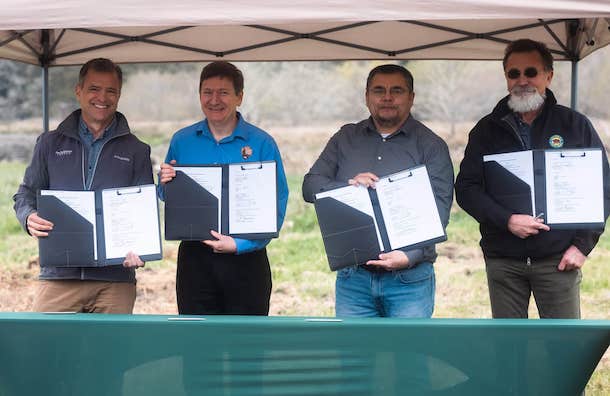
(From left) Save the Redwoods League President and CEO Sam Hodder, Redwood National and State Parks Superintendent Steven Mietz, Yurok Chairman Joseph L. James, and California State Parks North Coast Redwoods Superintendent Victor Bjelajac sign the landmark agreement at ‘O Rew. (Photo: Matt Mais, Yurok Tribe)
On the northern California coast the Yurok tribe is getting 125 acres of its stolen land back thanks to an historic partnership between the National Park Service, California State Parks, and Save the Redwoods League. Chairman of the Yurok Tribe Joseph L James joins Host Jenni Doering to describe how the land will help nurture Yurok cultural traditions.
Transcript
BELTRAN: It’s Living on Earth, I’m Paloma Beltran.
DOERING: And I’m Jenni Doering.
Over the last few centuries Native Americans have endured genocide, land theft, and attempts to erase their very cultures. But they are still here, and although the past can’t be changed, there is some healing now underway. On the northern California coast the Yurok tribe is getting some of its stolen land back thanks to an historic partnership.
The National Park Service, California State Parks, and Save the Redwoods League have agreed to transfer 125 acres of ancestral lands back into the hands of the tribe by 2026. For thousands of years the Yurok have lived near the mouth of the Klamath River, where the plentiful salmon nourished them and have been invoked in dance and music.
[“NEYPUY REK’WOY” SONG BY James Gensaw Sr.]
DOERING: This song called Neypuy Rek’Woy translates to “I went down to the mouth of the Klamath and caught a lot of salmon.”
[“NEYPUY REK’WOY” SONG]
DOERING: The place that the Yurok tribe is getting back is called O’ Rew in the Yurok language and includes habitat for young coho and chinook salmon. Joining me now is Joseph L. James, Chairman of the Yurok tribe. Chairman James, welcome to Living on Earth!
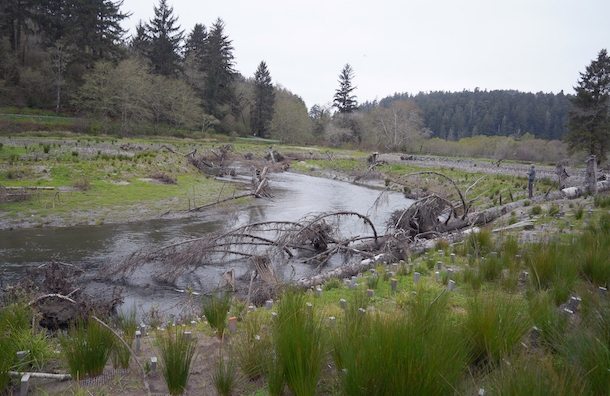
The 125-acre ‘O Rew property, part of traditional Yurok lands, used to be a mill site. (Photo: Matt Mais, Yurok Tribe)
JAMES: Thank you, glad to be here to talk about a historical moment for the Yurok tribe and its people.
DOERING: So first, Chairman James, can you tell me a bit about your people, the Yurok tribe, and your traditional lands? What are some of the core values of your culture?
JAMES: We're the largest populated tribe in the state of California. Our Yurok reservation is located in two counties, Humboldt and Del Norte county, up here in northern California along the Klamath River, just south of the Oregon border. We're river people. The Klamath River is our life way. We're a fishing tribe. So we're very grateful and appreciative of what the land and the river provides for us. Salmon and fishing, it's not just a food, it's our culture. It's our way of life as people.

Yurok children at play. The Yurok Tribe is the largest Tribe in the state of California, with over 6400 enrolled members. (Photo: Matt Mais, Yurok Tribe)
DOERING: And tell me more, please, about this place that we're talking about here, the 'O Rew land. You know, Save the Redwoods League is involved in this land back, so there must be redwoods there. I remember going to that Northern California coast a long time ago and it's very lush, rainy a lot of the time, but that makes it so prolific and there's so much nature and wildlife there. Can you describe that a little bit for us?
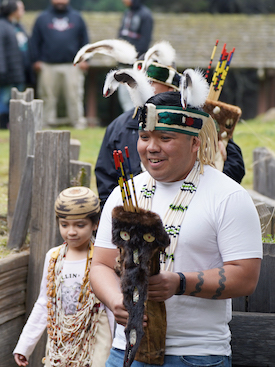
Tribal members in Yurok adornments. The Yurok Tribe plans to build a traditional village at the ‘O Rew site, where their community can gather for ceremonies and other cultural activities. (Photo: Matt Mais, Yurok Tribe)
JAMES: This property of 125 acres used to be a mill site, you know, where they decked back in the day-old growth logs and the large second old growth logs, specifically redwood. It's one of the southern areas from our reservation. It's a gateway into the redwoods. We have used redwoods for our ways of housing and lodging. We use our redwoods for our dugout canoes for traveling on the river. We also have streams running through the property along the highway. We have beaver there, we have small juvenile salmon, we have coho there. So, we're really excited to have our piece of property come back to the Yurok tribe, it's an old village site for us. It's exciting times.
DOERING: And by the way, what does 'O Rew mean in your language?
JAMES: It's the name of the village and location. A number of Yurok people have come from villages along the Klamath River and along the north coast. And so again, it's just our place of origin, where we come from.
DOERING: How do the Yurok people want to transform this piece of land that will be returned to you in 2026? What are your plans?
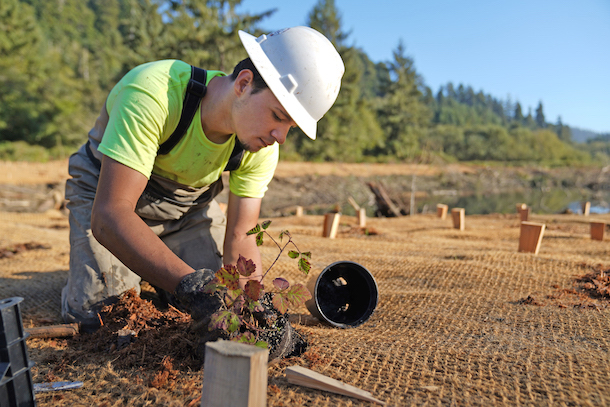
The Yurok people have been involved in restoring this area for over a decade. They plan to continue this work when the land is transferred to them in 2026. (Photo: Matt Mais, Yurok tribe)
JAMES: What we'll have is a visitor center here on the property, we'll also have a cultural center there, where we'll showcase our materials that we have used, whether it's making for boats, whether it's materials we gather for making baskets. So, we'll have our cultural items there that are appropriate to share. And then we'll also have a traditional village there that will be used by our tribal citizens. You know, we continue to dance, we continue to have our ceremonies, we continue to pray and continue to gather. We're looking forward to showcasing this with our young men, our young women and our adults, and a place to come, to gather, to continue that traditional practice. Also, this area, we have trail systems and networks of trails that we use for our ways of travel. And so, we're gonna include a network of trail systems there, using our Yurok language, using traditional knowledge of way showing and interpretive signage, plants, animals, what has the Yurok tribe since the beginning of time utilized these resources for, from a traditional perspective, not from a Western science perspective. That's what I'm so also proud of, the land not just coming back to us, but as first peoples, we get to share that knowledge and experience of what the work we have been doing since the beginning of time as people.
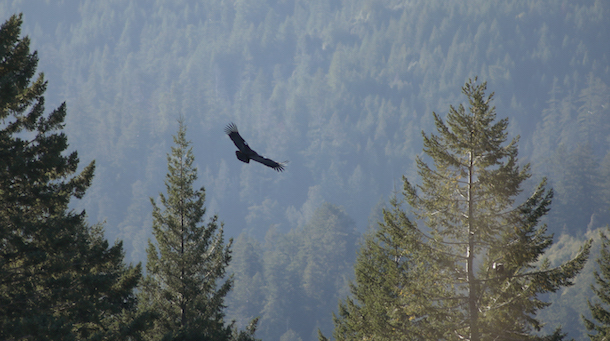
The Yurok Tribe has released 11 California condors in their ancestral areas. (Photo: Matt Mais, Yurok Tribe)
DOERING: So even though there has been logging of redwoods and other trees in this area, to what extent has the forest been able to grow back over time and with your help as well?
JAMES: Yeah, the Yurok tribe has been involved in this rehabbing the area to its original state for last 10 years. I'll start along the stream, the work that we've been doing, improving that stream habitat for our young juvenile fish to return, putting root wads in the streams, and also planting new trees along the stream bed to provide shade and canopy. It's exciting that we're doing the great work we're doing, improving habitat and salmon for future generations to come. You've got elk on the property. We just reintroduced the California condor. It's been 100 years since the California condors come back home to Yurok country. Now we have eleven flying California condors, probably about maybe 10 miles from this location. It's gonna take time, it's going to take time to bring the piece of property back to its original state, but we're fully invested in it. And we're able to have the help with our partners of Save the Redwoods, the California State Parks, and Redwood National Park. Our values and missions align. And we're continuing to continue that great work moving forward.

Elk roam the ‘O Rew area. (Photo: Matt Mais, Yurok tribe)
DOERING: Yeah, and this is a historic partnership with Redwood National Park, California State Parks and Save the Redwoods League working with the Yurok tribe on this land management. How have you collaborated with these folks in the past and how do you hope to grow that bond in the future?
JAMES: The Yurok tribe has a long-standing relationship with all three of them. The Yurok tribe has been working with the California state park system, you know they're located in the Yurok tribe's ancestral territory, so we do a lot of work with them, through trails improvements, through our cultural projects. You know, Redwood National Park is also located in the Yurok tribe's ancestral territory. So, the same model there, we've been working with the Redwood National Park regarding trails, maintenance. Save the Redwoods, you know, within the last 12, 13 years. They purchased this property in 2013. They are aware it was in the Yurok ancestral territory; they reached out to us. And, you know, we just had that conversation, and we've just grown over the years. And how you get to that trust is just sitting at the table in the room and growing that bond. Doesn't happen overnight, doesn't happen over, over one year. We're not looking to build trust for short term, we're looking to build for long term. And that's what you have here. And when I look at that, I've got a private organization, I've got a federal organization, and I've got a California state organization, giving land back to the Yurok tribe, right? You let that sink in. We all aligned and through discussion, partnership and trust, and collaboration, we are transferring 125 acres back to the ownership of the Yurok tribe. So, we're really proud of that.
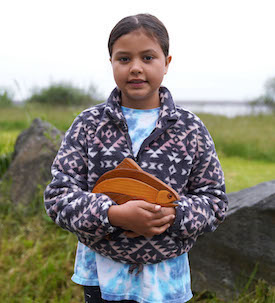
A Yurok child holds a wooden carving of a salmon. Salmon and fishing are an integral part of the Yurok culture. (Photo: Matt Mais)
DOERING: Chairman James, what is this return of the 'O Rew land mean for the Yurok people?
JAMES: It means healing. Healing for myself, healing for our people, and now we got to heal the land and the property. It means excitement, it means very proud, privileged, and honored to have this piece of property come back in the hands of Yurok. Knowing how far we have come through the state of California, even across the nation, as indigenous people. How far our ancestors have paved the way to get to this point, knowing our people had to get sent to boarding schools, knowing their language at one point tried to wipe our language away. It wasn't successful. We're still here today practicing our culture, our traditions. And when I see this piece of property, in a village coming back with the Yurok ancestral territory, it makes my heart feel good. But also at the same time, we've got a lot of work yet to do. This is just one piece of property that we have.
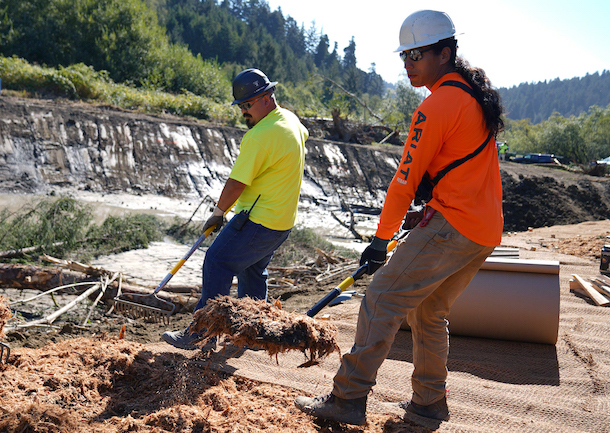
The Yurok people will steward the land alongside their partners, Save the Redwoods League, California State Parks, and the National Park Service. (Photo: Matt Mais, Yurok Tribe)
DOERING: We've heard in recent years about this movement for land back in North America. How do you hope that this project and this land transfer might kind of help ignite that and transfer into other traditional lands?
JAMES: We look at this partnership, the way we've come together, it's not just for us. It's for all of Indian country. It's for all of us to to share, this model is for us to share. And again, it's a first of its kind here in our neck of the woods, up here in northern California. So, it's truly a historical moment for our land to come home, gives not just us hope, but gives others hope.
DOERING: Joseph L. James is Chairman of the Yurok tribe. Thank you so much, Chairman James.
JAMES: Thank you for having me on the show.
Links
Living on Earth wants to hear from you!
Living on Earth
62 Calef Highway, Suite 212
Lee, NH 03861
Telephone: 617-287-4121
E-mail: comments@loe.org
Newsletter [Click here]
Donate to Living on Earth!
Living on Earth is an independent media program and relies entirely on contributions from listeners and institutions supporting public service. Please donate now to preserve an independent environmental voice.
NewsletterLiving on Earth offers a weekly delivery of the show's rundown to your mailbox. Sign up for our newsletter today!
 Sailors For The Sea: Be the change you want to sea.
Sailors For The Sea: Be the change you want to sea.
 The Grantham Foundation for the Protection of the Environment: Committed to protecting and improving the health of the global environment.
The Grantham Foundation for the Protection of the Environment: Committed to protecting and improving the health of the global environment.
 Contribute to Living on Earth and receive, as our gift to you, an archival print of one of Mark Seth Lender's extraordinary wildlife photographs. Follow the link to see Mark's current collection of photographs.
Contribute to Living on Earth and receive, as our gift to you, an archival print of one of Mark Seth Lender's extraordinary wildlife photographs. Follow the link to see Mark's current collection of photographs.
 Buy a signed copy of Mark Seth Lender's book Smeagull the Seagull & support Living on Earth
Buy a signed copy of Mark Seth Lender's book Smeagull the Seagull & support Living on Earth

